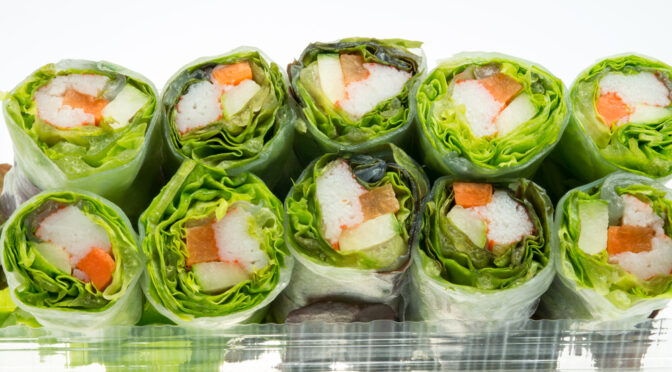The food we eat daily fuels us and gives our bodies the energy they need to function on a day to day basis. If you have a penchant for pizza and pasta, or can’t resist a muffin, you might actually be harming your body due to the wheat you’re consuming.
Celiac Disease 1% of the American population has been diagnosed with celiac disease, a hereditary autoimmune condition that causes adverse reactions to gluten in food, damaging the small intestine. However, a huge 83% of those with the autoimmune disorder are undiagnosed or misdiagnosed, so have no idea.
Other Issues With Wheat
Even if you don’t think you have celiac or a gluten intolerance, you might find that you start to fair better after cutting them from your diet anyway. Wheat has been linked to acne, headaches, and even the acceleration of the aging process, so reducing your intake, if not cutting it altogether, might do you a world of good.
Finally, most foods containing wheat have been processed in some way. Pastas, breads, pizzas, cereals have all been made with a heady mix of chemicals and additives which prolong their shelf life, make them taste a certain way or look a certain way, but certainly won’t do you any good.
The Trouble with Rice
White rice isn’t necessarily terribly bad for you, the main issue, is that it is pure carbohydrate (unless fortified with extra vitamins) and has almost no micronutrients, so ends up just being a filling, calorie loaded component of your meal. Additionally, each grain of brown rice is protected by a ‘shield’ that gives it its color, but is full of potentially toxic compounds.
Alternatives
If you want to cut grains from your diet, there are loads of creative ways that you can get your fix without compromising on taste. Not only that, but the ingredient substitutes bring with them a range of additional nutrients that you would otherwise miss out on. By making these foods in your own home, from scratch, you know exactly what’s going into the recipe, and therefore, into your body.
Here we’ve compiled 10 wheat and rice alternatives that you can start implementing into regular meals, to help gradually phase out your wheat consumption, and improve your dietary health.
1) Lettuce Wraps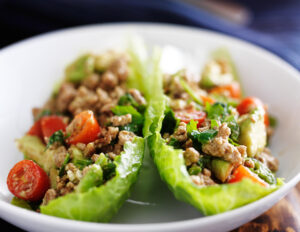
Ditch the carb loaded wheat wraps, and instead fill large lettuce leaves with your filling of choice.
Not only are they perfectly sized to hold the right amount of filling, but the lack of gluten, preservatives, and added sugar, means you’ll swerve the sugar spike that would typically follow with an ordinary wheat wrap.
Additionally, as a leafy green, you’ll get a ton of nutrients too.
2) Cauliflower “Rice”
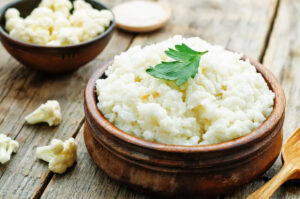 Increasingly popular, finely diced cauliflower can be used as as an alternative to rice for loads of dishes, great for if you’re craving a stirfry or need a quick and
Increasingly popular, finely diced cauliflower can be used as as an alternative to rice for loads of dishes, great for if you’re craving a stirfry or need a quick and
healthy side dish. You can make some by using a food processor and then lightly sautéing the cauliflower, keeping it tender, but with a little crunch.
Regular rice only really serves to fill you up, but this dish will do that and bring a whole host of nutrients at the same time. This alternative does carry a subtle flavor with it, however if you use it as a base for particularly flavorful meals, you won’t notice it.
3) Plantain Chips
You can find these pre-packaged in most large grocery stores, but these have usually been deep fried and heavily salted, so really aren’t that good for you. Try making your own by slicing some plantain, tossing them in coconut oil, and baking at 350 degrees for 30 minutes. Season lightly to taste.
4) Coconut Pizza Crust
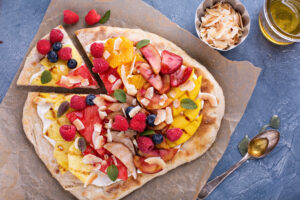 Pizza is probably the best food invention. Ever.
Pizza is probably the best food invention. Ever.
You can use coconut flour to replace grain flours, which not only helps you stay grain free, but increases fiber levels of the dish too.
Coconut flour is super versatile and can be used in loads of different recipes, just be sure to follow any instruction closely, as it notoriously absorbs a lot of liquid, so may need extra water and eggs.
5) Zucchini Noodles
These are really easy to make, and not only do they taste great, but they actually work really well as a spaghetti alternative you can twizzle them around your fork, and slurp them up to your heart’s content without them falling apart!
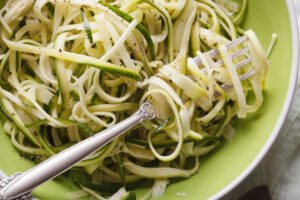
Using a spiralizer, you can shred zucchini into long noodles and use them in any of your favorite spaghetti recipes.
As with all of these grain alternative hacks, you get all the goodness of the replacement that you would otherwise be missing out on.
Zucchinis are an outstanding source of manganese and vitamin C, for example.
6) Chickpea Socca Bread
This bread has been baked in the Middle East for centuries. Instead of using regular flour, you can bake this with chickpea flour, olive oil, and spices, cutting the gluten content entirely. It ends up as a really dense and hearty bread that you can use in place of pitta as a starter with your dip of choice, or you can even use it as a glutenfree pizza base.
7) Jicama “Taco Shells”
Jicama is the vegetable you’re not eating, but should be! It’s a perfect low carb alternative to flour tortillas. You can make these taco shells by slicing jicama using a mandolin slicer into disks, which you then bake for 510 minutes. This will make them more pliable to wrap around your taco fillings. They are the perfect size, and you can continue Taco Tuesdays the healthy way!
8) Paleo Bread
You can still enjoy breads and muffins, even if you are living a grainfree or paleo lifestyle. Use almond and coconut flowers along with eggs and coconut oil as the base for all of your bakery favorites. They work for sweettoothed individuals just as well as those who prefer savory snacks.
9) Potato Buns
If you need a burger bun, or sandwich bread substitute, you can try making “buns” from potatoes. Slice a wide potato into rounds about 1?2 inch thick, bake them for 20 minutes at 350 degrees, and you have yourself a carb free bun!
10)Sweet Potato Rice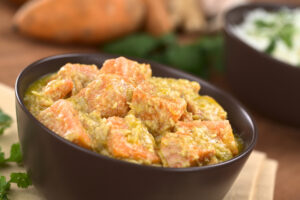
Sweet potato not only tastes great, but is an excellent source of vitamin A in the form of betacarotene, as well as bringing vitamin C, vitamins B1, B2, and B6, manganese, and potassium to the party.
Make this rice alternative by spiralizing the sweet potato, then coarsely chopping the long noodles into rice sized pieces before cooking a skillet for around 3 minutes, tossing frequently.
Cutting grains and rice from your diet doesn’t have to result in a drastic overhaul, nor does it mean you have to miss out on your old favorites. It could in fact result in a healthier lifestyle, with even more delicious meals!
http://www.beyondceliac.org/celiacdisease/factsandfigures/
http://health.usnews.com/healthnews/blogs/eatrun/2015/06/11/thinkyouresensitive-
toglutenthinkagain
https://draxe.com/sandwichsubstitutes/
http://www.whfoods.com/genpage.php?tname=foodspice&dbid=64
https://www.organicfacts.net/healthbenefits/vegetable/healthbenefitsofzucchini.html
http://paleoleap.com/aboutrice/

